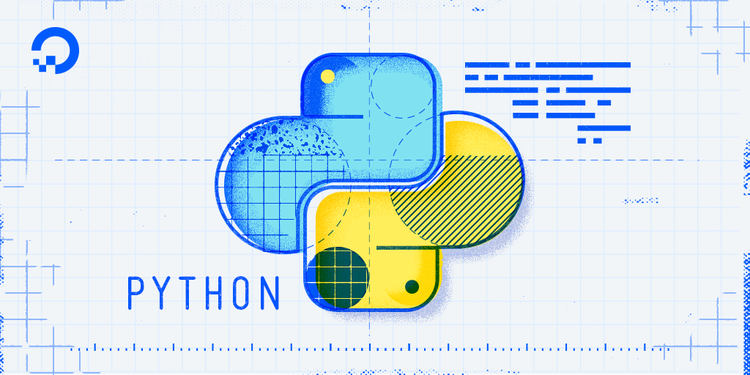datastruct-tut
Linked Lists
TOC
- Welcome
- Stacks
- Linked lists
- Introduction
- Singly Linked Lists as a stack
- Doubly Linked Lists as a queue
- Coding Challenge
- Binary Trees
Introduction to Linked Lists
Instead of using arrays which are contiguous blocks of memory we can implement various data structures with linked lists. We could use a linked list to implement the stack data structure we saw in the last module. Instead of contiguous blocks of memory, we’d use discrete nodes that point at the next node which then points at the next node ad infinitum. This has an advantage over arrays in that we don’t run the risk of running out of contiguous memory and end up having to copy the entire array to a new area with enough free contiguous memory to hold it. All typical stack operations would have the same big O notation performance as well.
A disadvantage is we can’t directly access any point in the linked list like we can with an indexed array, we’d always have to start at the front and work our way through the list to get to the desired node. So if you need to access middle nodes often a linked list would be a poor choice of implementation.
Singly Linked List
A singly linked list would work to represent the stack we saw in the previous module. Consider the linked list pictured below.

This stack, represented by a linked list has 3 nodes, or values, 32,42,12. 12 is at the top of the stack, 32 at the bottom.
This is a sample class that might represent a singly linked list. Note: It’s currently missing the push and pop operations a stack requires. We’ll add them soon.
class Stack:
'''
This represents a stack implemented by a singly
linked list.
'''
class Node:
'''
An individual node inside a linked list
'''
def __init__(self, data):
'''Initialize with provided data and no links.'''
self.data = data
self.next = None
def __init__(self):
'''Initialize an empty linked list.'''
self.head = None
def push(self, value):
'''Add a node to the top of the stack.'''
pass
def pop(self):
'''Remove a node from the top of the stack.'''
pass
Push
In a linked list that top node is a special node we typically call the head node. To add a new node to the top of the stack in a push operation we’d:
- Create a new node.
- We’d set this new nodes next to point at whatever the head points at.
- Point head at this new node.
For example suppose we push a new node containing the value 24 onto the stack pictured above. This is a O(2) operation. Below is what a push operation would visually look like.
Important: Remember to always point your new node at the old top node before you point head at the new node, otherwise you will lose your link to the old top node.
The only caveat to be aware of is when your pushing to an empty list, you’ll want to just point head at your new node and leave it’s next pointed at None.
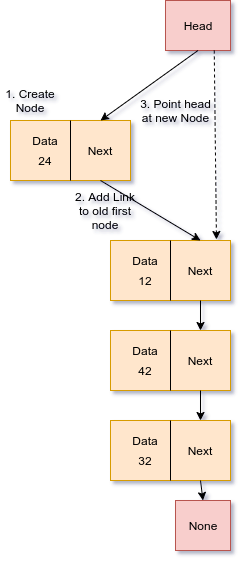
This is what that would look like in Python:
def push(self, value):
'''Adds a node to the top of the stack.'''
new_node = Stack.Node(value) # Create a new node
# This is that check for an empty list.
if self.head is None:
self.head = new_node
else:
new_node.next = self.head # This connects the new node to the old
self.head = new_node # This sets the new node as the new head
Pop
A pop operation is fairly straight forward.
- You will want to grab the data you are interested in from the first node.
- You’d point head at the next node on the list.
- Point your old top node at None.
Python’s garbage collector will delete the node for you. A pop operation is pictured below.
The only caveat to be aware of is you need to be aware of doing a pop operation on an empty linked list. Instead refuse to pop and print an error message.
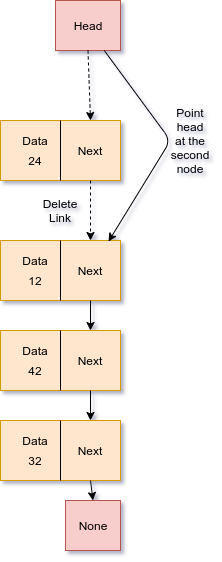
Here is what that would look like in Python.
def pop(self):
'''Removes a node from the top of a stack, and returns it's data'''
if self.head is None:
print("Can't pop an empty list")
return
else:
node = self.head # Temporarily store the node so we don't lose it when head is reassigned
data = node.data # Get the data from the node
self.head = node.next # Set head to the next item down
node.next = None # Set the node.next being popped to None, python will garbage collect it.
return data
The only thing that’s missing are some helper functions to help python navigate this data structure we have created. One is __iter__ which tells python how to loop through our stack. The second is __str__ which tells python how to represent our data structure as a string. These are given below.
def __iter__(self):
curr = self.head
while curr is not None:
yield curr.data
curr = curr.next
def __str__(self):
output = "stack["
first = True
for value in self:
if first:
first = False
else:
output += ", "
output += str(value)
output += "]"
return output
For a completed file containing this class see ll-single.py
I would suggest for practice attempt to solve the previous modules challenge with this new implemenation of a stack.
Additional thinking: If you needed to remove a node from the middle of the linked list how would you do that? It’s helpful to draw it out on a whiteboard.
Doubly Linked Lists
If you recall in the previous module we talked how about a line at a grocery store would perform terribly with the stack data structure. The data structure that solves this problem is called a queue, it can be implemented with a doubly linked list. A queue will add data to the end of the list, and remove data from the front. Both operations are O(1) when implemented with a doubly linked list. Queue’s are very useful anytime we want to process data in the order that it arrived.
Doubly linked lists are just like singly linked lists only they have an additional special node called the tail. It’s at the end of the list. Also every node in addition to pointing at the next node, points at it’s previous node. This means we can travel the linked list forwards and backwards. As a bonus because we aren’t relying on contiguous memory, if we remove an item from the front we don’t have to shuffle everything forward like we would need to with an array.
A doubly linked list might look as pictured below.
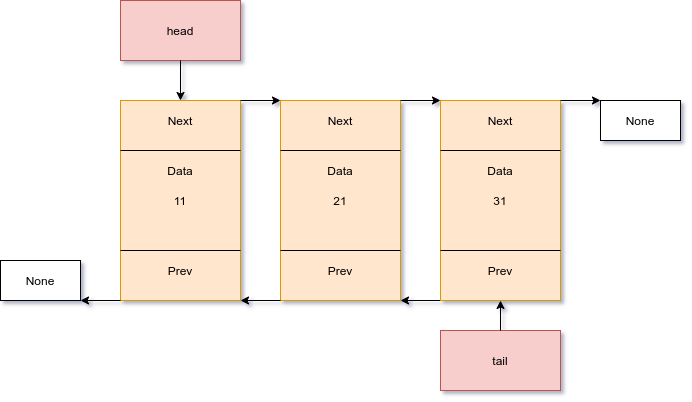
To get a doubly linked list working for a queue, we’ll need at least two operations.
An enqueue operation will allow us to put something into the queue, and dequeue would allow us to take something out of the queue to process it. These will actually be very similar to our push and pop operations already written for stacks. Below is a skeleton of our queue class in python:
notice how similar it is to a singly linked list?
class Queue:
'''
This represents a queue implemented by a doubly
linked list.
'''
class Node:
'''
An individual node inside a linked list
'''
def __init__(self, data):
'''Initialize with provided data and no links.'''
self.data = data
self.previous = None
self.next = None
def __init__(self):
'''Initialize an empty linked list.'''
self.head = None
self.tail = None
def enqueue(self, value):
'''Add a node to the end of the queue'''
pass
def dequeue(self):
'''Remove a node from the front of the queue.'''
pass
Enqueue
To enqueue an item, we will add it to the tail. To do this we:
- Create a new node.
- Link the new nodes previous property to the tail.
- Link the tails next property to our node.
- Make the new node the tail.
This enqueue operation is pictured below:
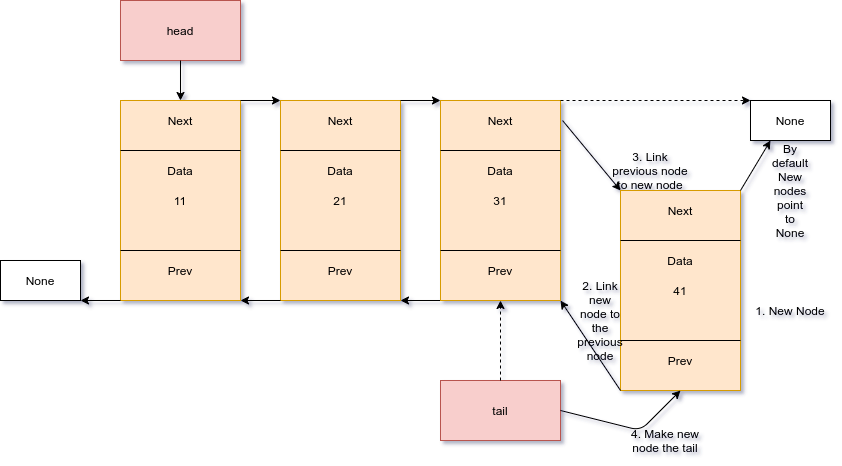
Using this, and you can use the singly linked lists push operation we’ve already programmed as a base, create your own enqueue operation. Please keep in mind some key differences. We are working at the tail not the head for the enqueue operation. Just like in the push operation, we need a special check for an empty linked list and we have one extra link to deal with, the previous link.
Check your solution against this completed solution: dl-enqueue.py
Dequeue
Next we need a dequeue operation. The dequeue operation will get the data from the first item in the linked list, and delete that first node. To do this operation we need to:
- Get the data from the first node.
- Store a temporary reference to the node.
- Make the next node the new head.
- Link the nodes next property to None.
- Link the new heads previous property to None.
- Return the data.
Below is a visual of this operation:
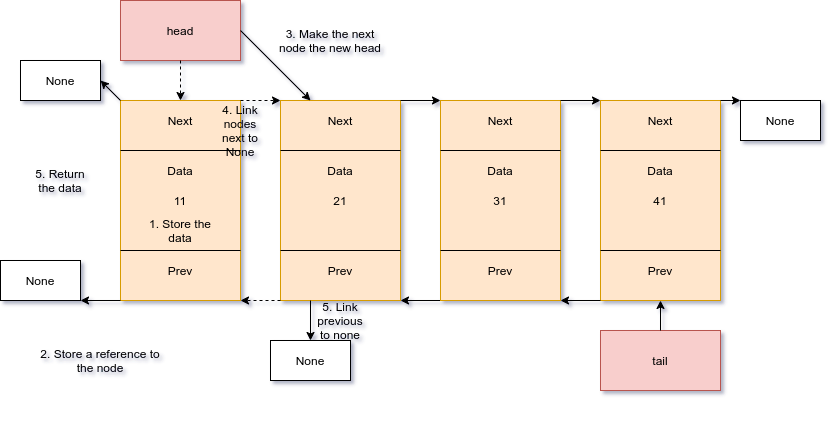
Using this, and again you can use the singly linked pop operation we’ve already programmed as a base, create your own dequeue operation. Please keep in mind that just like with the pop operation, you need to be aware of dequeueing an empty list. The only real difference is the extra link.
Check your solution against this completed solution: dl-dequeue.py
Coding Challenge
The coding challenge will be to implement a queue using a doubly linked list. The queue will be used to process athletes scores and output their rankings.
The athletes information will come in tuples (name, place, score). A process method is already written which takes the tuple passed to it and outputs what medal the athlete gets.
Luckily if you’ve already written the enqueue and dequeue operations, you’ve already done the work for this challenge. All you need to do is plug them into this starter code: 2-topic-starter.py.
Check your solution against this completed version: 2-topic-solved.py.
